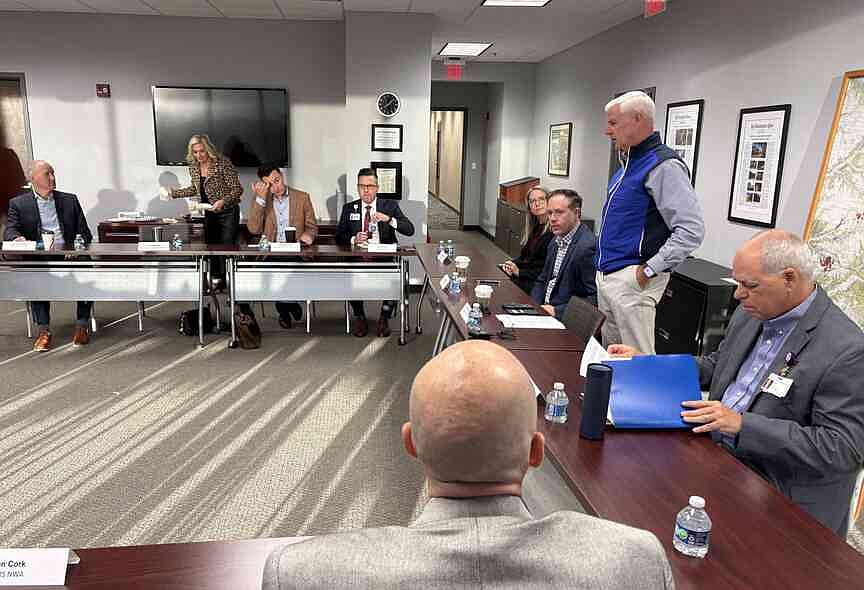Copyright The 19th*

Today, 4 out of every 10 women say they’ve experienced violence at the hands of an intimate partner. Among men, a quarter report being victims. Intimate partner violence can be deadly, particularly for women: More than half of all women homicide victims are killed by a current or former partner. Congress in 1989 declared October to be Domestic Violence Awareness Month, following a decades-long campaign to frame intimate partner violence as a national public health and safety issue — not a private family matter. That work eventually led to the passage of the Violence Against Women Act in 1994, creating a dedicated fund to support domestic violence shelters and crisis help organizations. In the over 30 years since, no other private or public organization has financed anti-domestic violence work as broadly or as deeply as the U.S. government. Without federal funds, the work being done to prevent intimate partner violence, feed families in shelters fleeing abuse or help survivors file for legal protection would not exist on the scale it does today. The disruption the Trump administration has wrought on this critical public safety and public health infrastructure is unprecedented, threatening a framework built over a half-century. Teams responsible for violence prevention have been decimated, and a reorganization of the Department of Health and Human Services has eliminated divisions wholesale. The president’s proposed budget, as well as the Republicans’ appropriations bill, suggests defunding many of the programs that remain. The federal budget will have the biggest impact on the nation’s network of domestic violence shelters and legal support for people escaping abuse. The fight over appropriations has shut down D.C. for 30 days. Cuts proposed by the Senate, the House and the president to programs financed through the Violence Against Women Act and the Family Violence Prevention and Services Act would trickle down to states, resulting in layoffs of lawyers and caseworkers, and fewer safe beds for kids to sleep in at family shelters. Realistically, all the grant programs and departments dealing with gender-based violence haven’t been fully funded for years. But the cuts suggested in the president’s budget show where the administration’s priorities lie, zeroing out programs dedicated to the prevention of sexual assault and engaging men to stop violence. These dramatic changes, both executed and proposed, are coming under the leadership of the first president to be found liable for sexual abuse in federal court. Just last month, Trump downplayed the seriousness of domestic violence crimes in a speech, alarming victims and advocates, who argued that Trump’s comments harken back to a time when domestic violence was seen as a private matter, leaving victims stuck in cycles of abuse and sometimes leading to deadly violence. “If a man has a little fight with the wife, they say this was a crime,” Trump said, referring to domestic violence as a “much lesser” crime. The White House later said Trump wasn’t “talking about or downplaying domestic violence.” Moving beyond a private matter Domestic violence shelters, rape crisis centers and victim services hotlines were uncommon before the 1970s. The first domestic violence shelter in the nation opened in Minnesota in 1974, funded by the local community. More shelters sprung up across the country over the next few years, and antiviolence advocates pushed for stronger legal action against perpetrators. At the time, police officers were instructed to treat domestic violence as a private matter and not intervene. Congress passed the Family Violence Prevention and Services Act (FVPSA) in 1984, creating a dedicated funding stream for shelters. In 1994, the Violence Against Women’s Act (VAWA) was passed and expanded resources for sexual assault response, domestic violence prevention and local law enforcement. VAWA has been reauthorized four times since, most recently in 2022, and has expanded scope to support immigrants, LGBTQ+ people and Native American tribes. VAWA, though not without its discontents, was a recognition that domestic violence was a national public health and safety crisis, not a private matter inside American homes. The money making this work possible Federal funding is critical to the country’s infrastructure combating domestic violence, both direct services to victims and prevention work done largely by national, state and local nonprofits. Direct services include providing housing, meals, and legal assistance for protective orders and restraining orders. These legal protections prevent abusers from owning guns in some states, reducing the rates of domestic violence homicides, which are most frequently carried out with a firearm. In addition to the dedicated sources of VAWA and FVSPA, another major source of funding is the Victims of Crime Act (VOCA), which provides help to survivors of any crime. Grants are funded through penalties and fines paid by those convicted of federal crimes — a fund that has been running low due to changes in how the Justice Department prosecutes white-collar crime. In this way, funding levels aren’t directly dictated by Congress beyond a cap. The Justice Department is the main department dealing with VAWA funds and programs, but funding for anti-domestic violence efforts comes through other departments and programs, as well: The Department of Housing and Urban Development (HUD) has funding set aside to help survivors facing homelessness and to help the department implement VAWA protections. In recent years, only the first program has been funded, at $52 million compared with the $75 million authorized. Several programs in the Department of Health and Human Services (HHS) specifically finance research and programming related to the prevention of domestic violence and sexual assault. Most programs were housed in the Division of Violence Prevention within the Centers for Disease Control and Prevention (CDC), which has been gutted through layoffs and additional cuts this year. Temporary funds made available through the American Rescue Plan Act of 2021 to support culturally-specific providers of domestic violence services helped nonprofits deal with an influx of abuse since the start of the COVID-19 pandemic. The last renewal for the grants ended in September 2025, leaving many organizations in a lurch as need has stayed steady. The federal government’s impact can be seen in the operation of the National Domestic Violence Hotline. According to the most recently available audit, close to three-quarters of The Hotline’s revenue in fiscal 2024, or over $20 million, came from the federal government. The Hotline, which offers callers in crisis guidance and counseling, received over 2,000 contacts a day in 2022, totalling over 775,000 texts, calls and chat requests over the course of the year. What this year’s appropriations fight puts at risk The programs authorized by VAWA and FVSPA are rarely funded at their full levels, and amounts tend to shift year-to-year. The budgets proposed by the House and the president include massive cuts to the programs enabling direct services and prevention schemes to operate. Some of the VAWA programs the president’s budget for 2025 proposes completely defunding are for providing culturally-specific services and LGBTQ+-specific programs, engaging men and boys in prevention and addressing cybercrime. Others face steep cuts. According to data gathered by the National Network to End Domestic Violence in August, the president’s proposed budget suggests cutting funding VAWA programs within the DOJ by over $200 million from fiscal 2025, to $505 million. For 2026, the Senate budget proposes $720 million and the House bill suggests $640 million, compared with $713 million for the last fiscal year. The Senate budget would increase the amount dedicated to improving policing and prosecution resources, in line with the DOJ’s focus on perpetrator accountability. No budget funds all the programs supported during the last fiscal year. These DOJ programs enable essential operations for the domestic violence safety net across the nation and are a negligible amount of the federal budget. For context, the DOJ spent $44 billion in fiscal 2024, making up 0.6 percent of the total government budget, per the nonpartisan organization USA Facts. VAWA programs accounted for $713 million that same year, or 1.6 percent of DOJ funds. Some of the most consequential proposed cuts would impact programs housed in HHS and HUD. Various prevention programs at the CDC focused on domestic violence and sexual assault prevention would be combined, and their cumulative funds slashed in half. The CDC has been significantly reorganized after several purges of the civilian workforce. The president’s budget tightens the belt even more. The CDC houses the federal government’s intimate partner violence and sexual assault prevention efforts, which includes teams researching prevention solutions and producing public materials based on them. Other specialized CDC staff were responsible for helping organizations implement evidence-backed prevention strategies in their communities, like the program Coaching Boys Into Men. However, the CDC workforce responsible for this work was severely decimated earlier this year. The flagship program focused on preventing teen dating violence lost nearly all of its staff. CDC programs like grants targeted to rape prevention and education still exist, but have lost the experts who knew how to implement cutting-edge research in communities. If budget cuts are approved, this will impact the capacity of state and local grantees to do this work. Few others step up to bankroll essential services Only some states allocate funds toward domestic violence, and it is much less. The states that do budget for these services can face the same problems as Congress. For instance, Pennsylvania has set asides but the state budget has been waiting for passage since July. The chief executive of the Pennsylvania Coalition to End Domestic Violence told local news network NBC10 in October that the state owes the nonprofit $11 million. Very few foundations prioritize support to organizations focused on supporting domestic violence and sexual assault survivors. Less than 2 percent of philanthropic giving in the United States goes toward causes for women and girls, and 0.1 percent goes toward LGBTQ+ causes. Even less goes toward violence prevention and direct services. The private funding landscape took a huge hit in 2020, when the NoVo Foundation, run by Peter and Jennifer Buffet, eliminated its initiative backing groups fighting sex trafficking and domestic violence. NoVo was the largest donor to gender-based causes by a significant amount. There is even less support for groups working to end sexual assault. The Fund To Prevent Sexual Assault launched an open call for new ideas this year but is focused on supporting tech solutions and not direct services. Some individual organizations are working to diversify their sources of funding. FORGE, one of the only organizations in the country focused specifically on transgender victims of violence, renewed its call for individual donations amid threats to its funding by the Trump administration. One-time supporters are encouraged to donate $1,994 for the year the organization was founded, or $100 to cover the cost of care packages for three trans survivors. The fight for funding As the Trump administration tries to restrict access to this funding based on its ideology, advocates are anticipating greater disparities between red and blue states. Krista Colon, public policy director of the California Partnership to End Domestic Violence, said she is concerned that lawsuits filed by Democratic attorneys general suspending restrictions on providing support to immigrant survivors may bring relief to only Democrat-led states. Organizations in Republican-led states that find themselves cut off from federal funds may not find relief from their state leaders in the form of lawsuits or funding from state coffers. Nonprofits dedicated to supporting survivors have sued the Trump administration over restrictions on spending that they say would prevent them from assisting trans people or immigrants experiencing abuse. Judges have sided with them so far.



